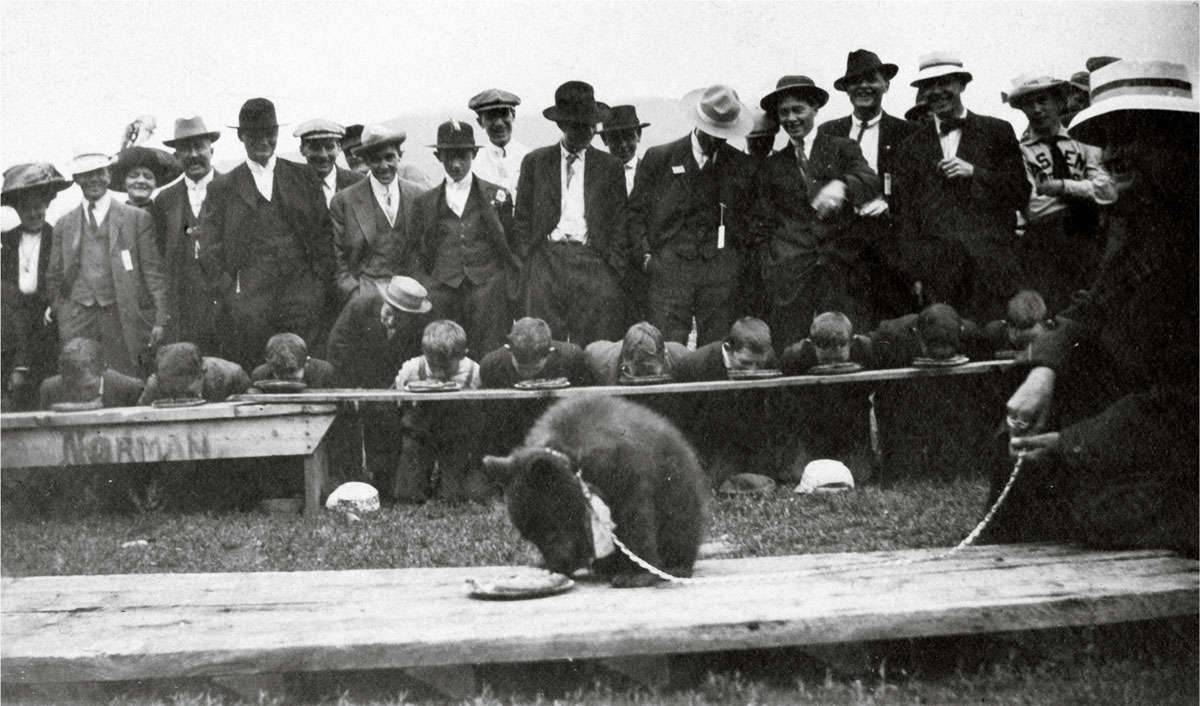Be Bear Aware
“Don’t feed the bears” might be the most appropriate caption for this photo.
But in 1912 Aspenites had a slightly different relationship with wildlife than we do today. The actual caption under this photograph in the Aspen Democrat- Times reads: “A pie-eating contest during the 1912 Fourth of July celebrations in Aspen. The contest was put on by the Crystal City Club. Pies are lined up on a low wooden bench, with boys standing behind them. In the foreground, a man is feeding a pie to a small bear cub, the mascot of the contest.”
Newspaper reports from earlier that year indicate the cub pictured here might have been an orphan. In May 1912, the Democrat-Times reported a cub in town with no mention of the little guy’s (or gal’s) sow.
The picture makes it feel like bears were regulars at pie-eating contests back in the early 1900s, but it wasn’t a common sight, and still shouldn’t be, says Mike Porras, spokesman for Colorado Parks and Wildlife.
Porras says people often interact with the wildlife they encounter by offering food, and that typically leads to trouble. “It does more harm than good.”
There has been a proliferation of bear encounters in Aspen and Snowmass in recent years, primarily due to a scarcity of natural food sources. Late-spring freezes meant bears haven’t been able to find food in the high country, so they come to lower elevations in search of grub. They don’t need to travel far to end up in Aspen, where unsecured trash is one of the most plentiful sources of food available. And once they find a “honey spot,” Porras says, they’ll return to the source.
Human-bear interactions have been such an issue in recent years that the city of Aspen has taken an increasingly active role in wildlife enforcement. Police officers are sometimes dispatched when bears are roaming through neighborhoods. And city council has adopted ever more strict rules requiring people to secure trash in bear-resistant containers.
Nevertheless, almost every year there are reports of bears that find their way into somebody’s kitchen, either by opening a door that is not locked or crawling through an open window. Suffice it to say that a bear in your kitchen will leave a very big mess for you to clean up.
Unfortunately, bears are euthanized when they continue to cause problems. Fourteen were put down in the Roaring Fork Valley last year, according to the Aspen Daily News.
Porras reminds people that humans live in bears’ natural habitat. There are an estimated 17,000 to 20,000 black bears across Colorado, and many live in the mountains around Aspen.
“We consider wild animals to be just that,” he says. “Enjoy them responsibly and at a distance.”
So this summer, be bear aware and don’t feed them anything—including pie.
Edible Traditions is produced by the Aspen Historical Society. For access to the full online archives, including more than 10,000 historic images, visit AspenHistory.org or call 970.925.3721.





